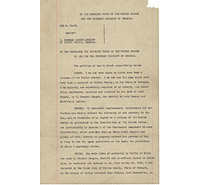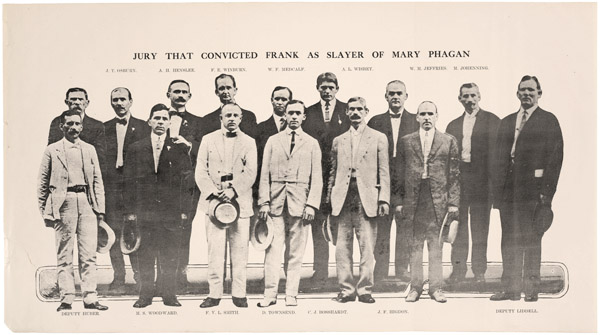
Progressive Era: Leo Frank Petition
The Leo Frank Petition: A Cry of Injustice Ignored
Background:
In today’s world of cultural and racial diversity, it is hard to comprehend the discrepancies and injustice of the Leo Frank Case of 1913. Frank, a Jewish businessman from New York and manager of a pencil factory in Atlanta, is put on trial for his life for the rape and murder of his thirteen year-old employee, Mary Phagan, whose body had been found in the basement of the factory by the night watchmen. The prosecution’s case depended on the last of four different affidavits given by Jim Conley, a black janitor at the factory. Oddly, at this time in the American South, evidence presented by an African American against a white person would have rarely been given credence, let alone evidence from someone who had changed their story three different times.
Based on this evidence, public outcry for a guilty verdict reverberated through Atlanta. Interested visitors filled the courtroom and, in the heat of a Georgia summer, an overflow of locals crowded around the open windows of the courthouse, cheering on the prosecution against the Jewish factory manager from the north. Near the end of the trial, the judge so feared the crowd that he suggested to the defense attorneys that an unfavorable verdict might cause the crowd to lynch Frank on the spot and that it would be best that the defendant not be in the courtroom at that time. He added that a similar fate might befall the defense attorneys as well. The defense attorneys agreed and both they and Leo Frank were absent in the courtroom when the jury announced the guilty verdict and the judge sentenced Frank to be executed.
The petition below is Leo Frank’s appeal to the U.S. District Court, hoping that the Federal judiciary would find the injustice in the process applied in the county court. Amazingly, Frank had already appealed through the state judiciary and they had concurred with the lower court’s ruling. Even more amazingly, he did not find justice in the Federal courts either. It is finally the governor of Georgia, John M. Slaton, who in 1915, based on his conviction that Leo Frank was innocent, commuted his death sentence to life imprisonment.
The story does not end there. On the night of August 16, 1915 a mob of prominent citizens break into the prison farm, abduct Frank, and lynch him the following morning.
In reaction to the Leo Frank trial, the B’nai B’rith Society formed the Anti-Defamation League in 1913 to combat anti-Semitism and other forms of bigotry. During this same decade, America witnessed the rise of the second Ku Klux Klan promoting anti-Jewish and anti-Catholic sentiment along with its old agenda.
The tale of the Leo Frank Case finally ended in the 1980’s with the 1982 testimony of Alonzo Mann, an office boy in the pencil factory in 1913. Threatened with death by Jim Conley and told to keep quiet by his mother, the eighty-three year-old Mann finally told of seeing Conley carrying the dead body of Mary Phagan to the basement of the factory on the day of her death. In 1986 the Georgia State Board of Pardons and Paroles pardoned Leo Frank.
Documents:
Suggestions for Classroom Use
Divide the class in to six groups. Give each group the first page and two other sequential pages (do not use pages 14 or 15). After reading the pages ask the groups to answer the following questions in open classroom discussion (not all of the below questions can be answered from each group’s pages).
- From your prior knowledge about trials and courtrooms, do the proceedings of Leo Frank’s trial seem judicial? If not, give examples of how they are inappropriate, unfair, or unjust.
- To how many different courts has Leo Frank appealed? Name them.
- Do you think the argument found in Leo Frank’s petition is grounds for his full release and freedom? Why or why not?
- Do you think his argument is grounds for a new trial?
- Do you think Leo Frank was denied his Constitutional Rights under the Fourteenth Amendment? What does the Fourteenth Amendment guarantee each citizen?
- Does the petition ever state whether Leo Frank is guilty or innocent?
- Do you think a statement of innocence within the petition might have changed the different courts’ opinions about a possible re-trial or the overturning of the verdict?
- What more information would you like to know about the case that is not found within the petition?
After the classroom discussion either handout copies, or read aloud, the background information found above. Ask your students to verbalize their questions, statements and ultimate conclusion about the Leo Frank Case (a quick Internet search engine inquiry will find even more details about the Leo Frank Case).
Possible guiding questions for further discussion might be –
- Is there any parallel between this case and what happened in Germany in the 1930s?
- What is notable about Jim Conley being allowed to give testimony against Leo Frank?
- Many people during the time of the trial did believe that Leo Frank was guilty but certainly not everyone did as is exampled by Governor Slaton. Why did more people not speak out? What did they have to fear?
- What can happen in a society where people are afraid to stand up and do or say what is right and true?
If a teacher finds unique and effective ways to use these documents in their classroom and would like to share them with other teachers, please contact education@nara.gov.

